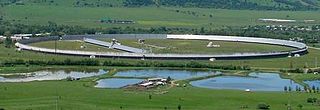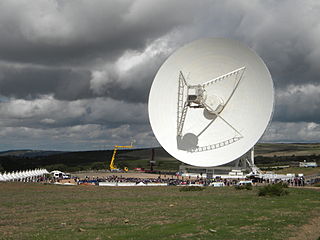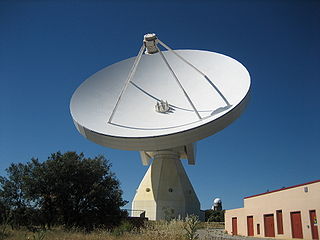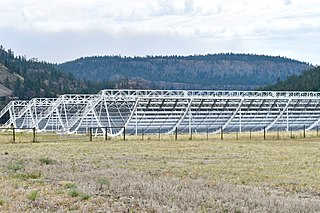
A radio telescope is a specialized antenna and radio receiver used to detect radio waves from astronomical radio sources in the sky. Radio telescopes are the main observing instrument used in radio astronomy, which studies the radio frequency portion of the electromagnetic spectrum emitted by astronomical objects, just as optical telescopes are the main observing instrument used in traditional optical astronomy which studies the light wave portion of the spectrum coming from astronomical objects. Unlike optical telescopes, radio telescopes can be used in the daytime as well as at night.

The Dominion Astrophysical Observatory, located on Observatory Hill, in Saanich, British Columbia, was completed in 1918 by the Canadian government. The Dominion architect responsible for the building was Edgar Lewis Horwood. The main instrument is the 72-inch-aperture (1.83 m) Plaskett telescope, proposed and designed by John S. Plaskett in 1910 with the support of the International Union for Cooperation in Solar Research.

Parkes Observatory is a radio astronomy observatory, located 20 kilometres (12 mi) north of the town of Parkes, New South Wales, Australia. It hosts Murriyang, the 64 m CSIRO Parkes Radio Telescope also known as "The Dish", along with two smaller radio telescopes. The 64 m dish was one of several radio antennae used to receive live television images of the Apollo 11 Moon landing. Its scientific contributions over the decades led the ABC to describe it as "the most successful scientific instrument ever built in Australia" after 50 years of operation.
The Cavendish Astrophysics Group is based at the Cavendish Laboratory at the University of Cambridge. The group operates all of the telescopes at the Mullard Radio Astronomy Observatory except for the 32m MERLIN telescope, which is operated by Jodrell Bank.

The Submillimeter Array (SMA) consists of eight 6-meter (20 ft) diameter radio telescopes arranged as an interferometer for submillimeter wavelength observations. It is the first purpose-built submillimeter interferometer, constructed after successful interferometry experiments using the pre-existing 15-meter (49 ft) James Clerk Maxwell Telescope and 10.4-meter (34.1 ft) Caltech Submillimeter Observatory as an interferometer. All three of these observatories are located at Mauna Kea Observatory on Mauna Kea, Hawaii, and have been operated together as a ten element interferometer in the 230 and 345 GHz bands. The baseline lengths presently in use range from 16 to 508 meters. The radio frequencies accessible to this telescope range from 194–408 gigahertz (1.545–0.735 mm) which includes rotational transitions of dozens of molecular species as well as continuum emission from interstellar dust grains. Although the array is capable of operating both day and night, most of the observations take place at nighttime when the atmospheric phase stability is best.

The Low-Frequency Array (LOFAR) is a large radio telescope, with an antenna network located mainly in the Netherlands, and spreading across 7 other European countries as of 2019. Originally designed and built by ASTRON, the Netherlands Institute for Radio Astronomy, it was first opened by Queen Beatrix of The Netherlands in 2010, and has since been operated on behalf of the International LOFAR Telescope (ILT) partnership by ASTRON.

The 1.2 meter Millimeter-Wave Telescope at the Center for Astrophysics | Harvard & Smithsonian and its twin instrument at CTIO in Chile have been studying the distribution and properties of molecular clouds in our galaxy and its nearest neighbours since the 1970s. The telescope is nicknamed "The Mini" because of its unusually small size. At the time it was built, it was the smallest radio telescope in the world. Together, "The Mini" and its twin in Chile have obtained what is by far the most extensive, uniform, and widely used galactic survey of interstellar carbon monoxide. "The Mini" is currently in operation from October to May each year.

The RATAN-600 is a radio telescope in Zelenchukskaya, Karachay–Cherkess Republic, Russia. It comprises a 576 m diameter circle of rectangular radio reflectors and a set of secondary reflectors and receivers, based at an altitude of 970 m. Each of the 895 2×7.4 m reflectors can be angled to reflect incoming radio waves towards a central conical secondary mirror, or to one of five parabolic cylinders. Each secondary reflector is combined with an instrumentation cabin containing various receivers and instruments. The overall effect is that of a partially steerable antenna with a maximum resolving power of a nearly 600 m diameter dish, when using the central conical receiver, making it the world's largest-diameter individual radio telescope.

The Algonquin Radio Observatory (ARO) is a radio observatory located in Algonquin Provincial Park in Ontario, Canada. It opened in 1959 in order to host a number of the National Research Council of Canada's (NRC) ongoing experiments in a more radio-quiet location than Ottawa.

The Institute of Astronomy of Nicolaus Copernicus University in Toruń, known prior to 1 October 2019 in scientific publications as the Toruń Centre for Astronomy, is an optical and radio observatory located at in Piwnice, about 15 km north of Toruń, Poland. It houses two single-dish antenna telescopes, 32 metres and 15 metres in diameter, as well as the largest Polish optical telescope – 90 cm Schmidt-Cassegrain camera. The facility is operated by the Nicolaus Copernicus University. Also, photometry using 60 cm Cassegrain telescope is made and radio measurements of the Sun at 127 MHz frequency have been recorded on a daily basis since 1958 using a 23 m interferometer.

The Medicina Radio Observatory is an astronomical observatory located 30 km from Bologna, Italy. It is operated by the Institute for Radio Astronomy of the National Institute for Astrophysics (INAF) of the government of Italy.

The NRC Herzberg Astronomy and Astrophysics Research Centre is the leading Canadian centre for astronomy and astrophysics. It is based in Victoria, British Columbia. The current director-general, as of 2021, is Luc Simard.
Arthur Edwin Covington was a Canadian physicist who made the first radio astronomy measurements in Canada. Through these he made the valuable discovery that sunspots generate large amounts of microwaves at the 10.7 cm wavelength, offering a simple all-weather method to measure and predict sunspot activity, and their associated effects on communications. The sunspot detection program has run continuously to this day.

Okanagan Falls is a community located on the south end of Skaha Lake in British Columbia.

The Sardinia Radio Telescope (SRT) is 64-metre fully steerable radio telescope near San Basilio, Province of Cagliari, Sardinia, Italy. Completed in 2011, it is a collaboration between the Istituto di Radioastronomia di Bologna, the Cagliari Observatory (Cagliari) and the Arcetri Astrophysical Observatory (Florence).

The Yebes Observatory RT40m, or ARIESXXI, is a radio telescope which is part of the observatory at Yebes, Spain. It is a 40-metre Cassegrain–Nasmyth telescope.

The Canadian Hydrogen Intensity Mapping Experiment (CHIME) is an interferometric radio telescope at the Dominion Radio Astrophysical Observatory in British Columbia, Canada which consists of four antennas consisting of 100 x 20 metre cylindrical parabolic reflectors with 1024 dual-polarization radio receivers suspended on a support above them. The antenna receives radio waves from hydrogen in space at frequencies in the 400–800 MHz range. The telescope's low-noise amplifiers are built with components adapted from the cellphone industry and its data are processed using a custom-built FPGA electronic system and 1000-processor high-performance GPGPU cluster. The telescope has no moving parts and observes half of the sky each day as the Earth turns.

The Algonquin 46m radio telescope (ARO) is a radio telescope at the Algonquin Radio Observatory, Canada. This radio telescope is historically famous for taking part in the first successful very long baseline interferometry experiment in the 1960s, where it was experimentally arrayed with the 26-metre Telescope at the Dominion Radio Astrophysical Observatory near Penticton, British Columbia.

Sean Dougherty is a Canadian astrophysicist who has been involved in a large number of radio astronomical facilities, both Canadian and international.




















